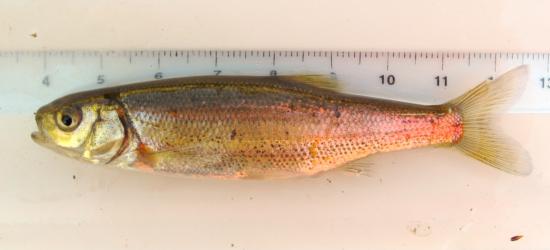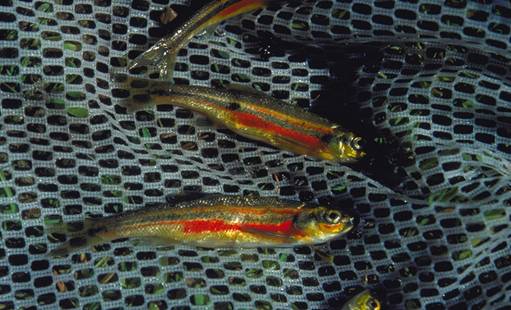Lahontan redside
-
Scientific NameRichardsonius egregius
-
NativeYes
-
Identification
 Lahontan redside, caught in Bogard Spring Creek (Eagle Lake watershed) in 2011. Photo by Teejay O'Rear. Scale in cm.
Lahontan redside, caught in Bogard Spring Creek (Eagle Lake watershed) in 2011. Photo by Teejay O'Rear. Scale in cm. Lahontan redside. Photo courtesy of Professor Peter B. Moyle.
Lahontan redside. Photo courtesy of Professor Peter B. Moyle.- Small, skinny minnow (TL 4 x body depth), max. length 16 cm TL
- Large eyes, deeply forked tail, terminal mouth (maxilla only reaches front end of eye)
- Breeding adults: red or scarlet lateral band amidst yellow, olivaceous back, silver underside, breeding tubercles present
- Males: tubercles larger and more numerous, present on pectoral fins, darker colorations, pectoral fins reach pelvic origin when depressed
- Non-breeding adults: red-stripe reduced or absent, lateral band still visible
- Fin Rays: dorsal 7-8, anal 8-20
- Lateral Line Scales: 52-63
-
Life History
Lahontan resides are native to both lakes and streams on the eastern side of the Sierra Nevada mountain range, although they have been introduced to the upper reaches of some watersheds on the western side of the range. River and stream inhabitants tend to occupy different niches within the waterway depending upon size. Adults hold in the top of pools near salmonids while the juvenile fish stick closer to the stream margins. The diet of stream residents may include drifting insects as well as benthic insects and algae. They tend to feed at night in order to avoid predators such as birds. Lahontan redsides may have important interactions with other species such as Tahoe suckers and brown trout. Sucker populations may suffer when their eggs provide food and nutrients for the Lahontan redsides, whereas the brown trout can prey heavily upon the redside and limit their populations. Lahontan redsides living in lakes tend to shoal and forage by swimming in the littoral zone. A diet study in Lake Tahoe found that these fish feed on both benthic and surface organisms, though primary food targets may vary highly throughout the day. In Eagle Lake the primary constituents of the Lahontan redside diet include caddisfly larvae, planktonic cladocerans, and amphipods. Lahontan redsides reach sexual maturity in the summer of year 3-4, and their growth rates are similar everywhere though fish in colder waters tend to grow slightly slower. Spawning occurs between late May and August with a peak at the end of June. During this time lake-dwelling Lahontan redsides often move up into tributary streams to breed. Spawning takes place over gravel in riffles or pool tails. Females in Lake Tahoe produce and average of 1,125 eggs. Groups of 20-100 fish swim over the spawning gravels and release their eggs and milt. The fertilized eggs become lodged in the substrate where they will incubate and later hatch. The newly hatched young swim down to slow water at the mouth of the spawning stream and hide in shoals under cover. The Lahontan redside has a maximum lifespan of around 5 years.
-
Links to Other ResearchN / A

